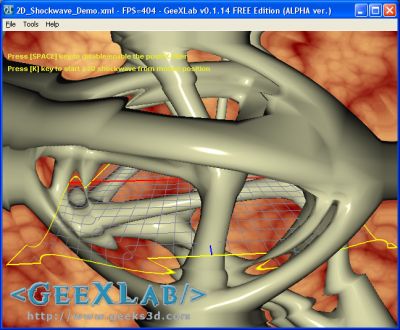
Geeks3D’s shader library is available in HERE.
This new shader shows a 2D shockwave post processing effect. In the GeeXLab demo, just hit the [K] key to create a shockwave at the mouse position. I found the original shader here.
You can download the demo here:
[download#110#image]
This demo requires GeeXLab and does not use Python so you can use the version of GeeXLab without Python. This demo has been tested with GeeXLab 0.1.14.
Unzip the source code somewhere, start GeeXLab and drop the 2D_Shockwave_Demo.xml file in GeeXLab.
Here is a video of the effect in action (the 2d grid has been added to better visualize the shockwave effect):
[youtube 8emVKwiWbOY]
Shader desription
Language: OpenGL 2 – GLSL
Type: Post processing filter.
Inputs
- sceneTex (sampler2D): the final scene image.
- center (vec2): mouse position (in texture coord space: [0 ; 1]).
- time (float): shockwave elapsed time in second.
- shockParams (vec3): shockwave parameters
Ouputs: color buffer
[Vertex_Shader]
void main(void)
{
gl_Position = ftransform();
gl_TexCoord[0] = gl_MultiTexCoord0;
}
[Pixel_Shader]
uniform sampler2D sceneTex; // 0
uniform vec2 center; // Mouse position
uniform float time; // effect elapsed time
uniform vec3 shockParams; // 10.0, 0.8, 0.1
void main()
{
vec2 uv = gl_TexCoord[0].xy;
vec2 texCoord = uv;
float distance = distance(uv, center);
if ( (distance <= (time + shockParams.z)) &&
(distance >= (time - shockParams.z)) )
{
float diff = (distance - time);
float powDiff = 1.0 - pow(abs(diff*shockParams.x),
shockParams.y);
float diffTime = diff * powDiff;
vec2 diffUV = normalize(uv - center);
texCoord = uv + (diffUV * diffTime);
}
gl_FragColor = texture2D(sceneTex, texCoord);
}
That’s a neat effect. I will check it out in GeeXLab, thanks!
Thanks !
It was realy usefull to me. There is the HLSL version I made from your code:
texture myTexture;
sampler2D samplerState = sampler_state {
Texture = ;
MinFilter = Point;
MagFilter = Point;
MipFilter = Linear;
AddressU = CLAMP;
AddressV = CLAMP;
};
float xcenter;
float ycenter;
float magnitude;
float width;
struct VS_OUTPUT
{
float4 Position : POSITION;
float2 TexCoords : TEXCOORD0;
};
float4 shockwave (VS_OUTPUT Input) : COLOR0
{
float4 colour;
float xdif = Input.TexCoords.x – xcenter;
float ydif = Input.TexCoords.y – ycenter;
float2 center;
center.x = xdif;
center.y = ydif;
float distance = sqrt(xdif * xdif + ydif * ydif);
if((distance = magnitude – width)){
float diff = (distance – magnitude);
float powDiff = 1.0 – pow(abs(diff*10.0), 1.5);
float diffTime = diff * powDiff;
float2 diffUV = normalize(Input.TexCoords – center);
Input.TexCoords = Input.TexCoords + (diffUV * diffTime);
}
colour = tex2D(samplerState, Input.TexCoords);
return colour;
}
technique Main {
pass P0{
PixelShader = compile ps_2_0 shockwave();
}
}